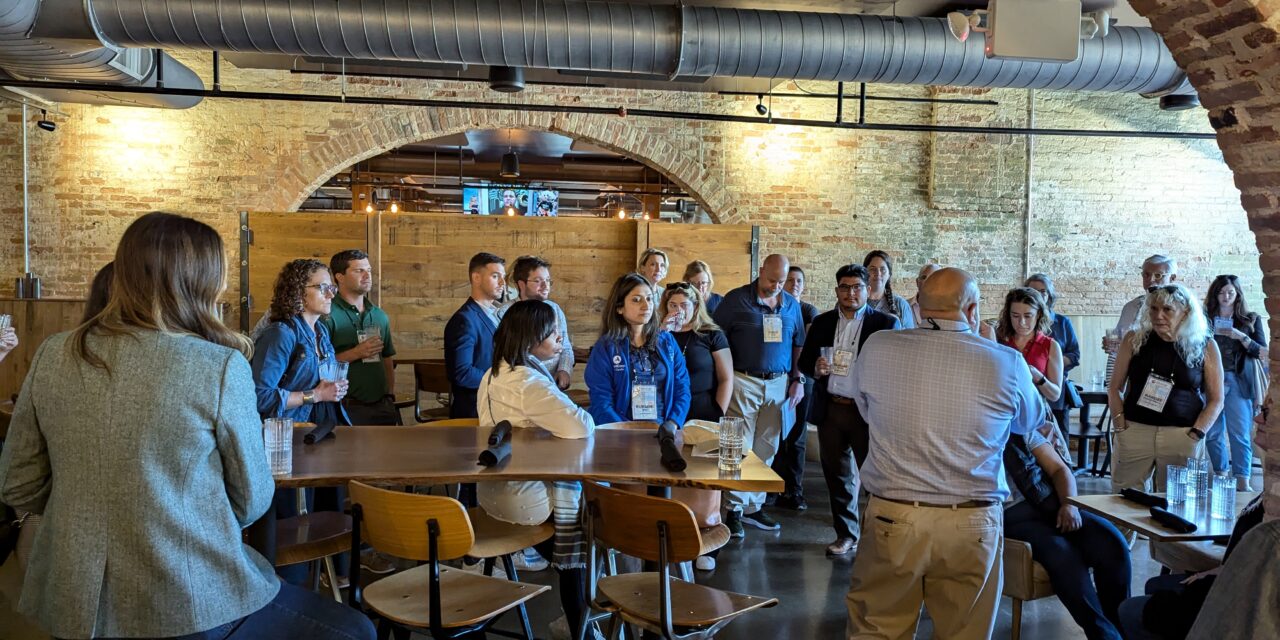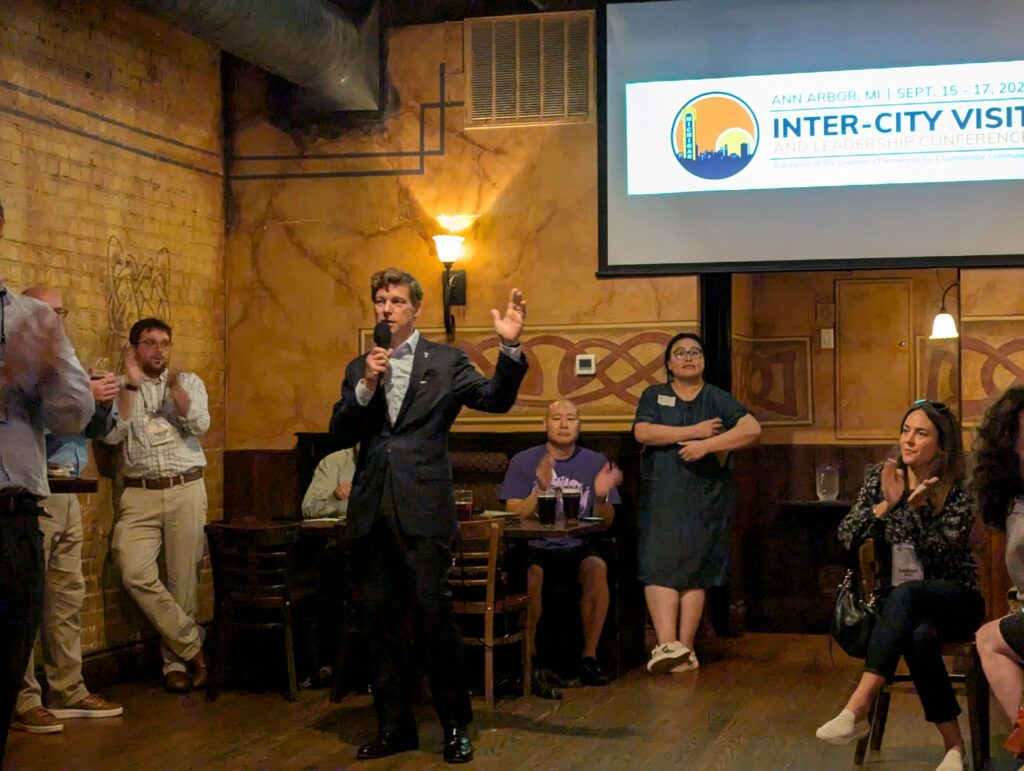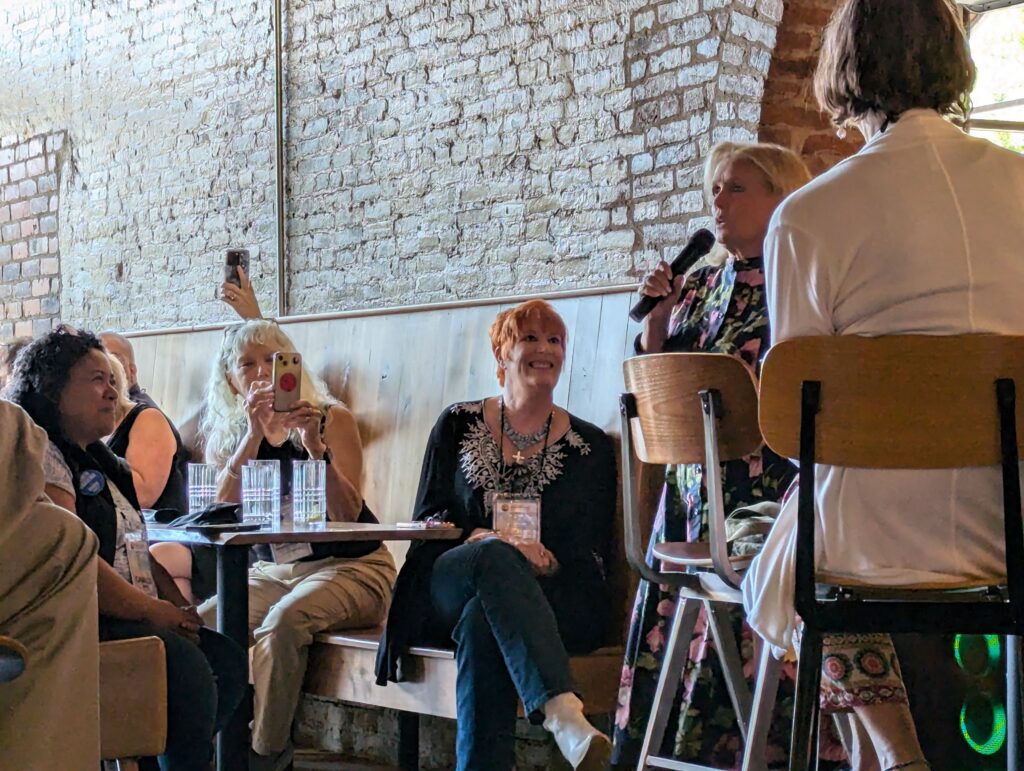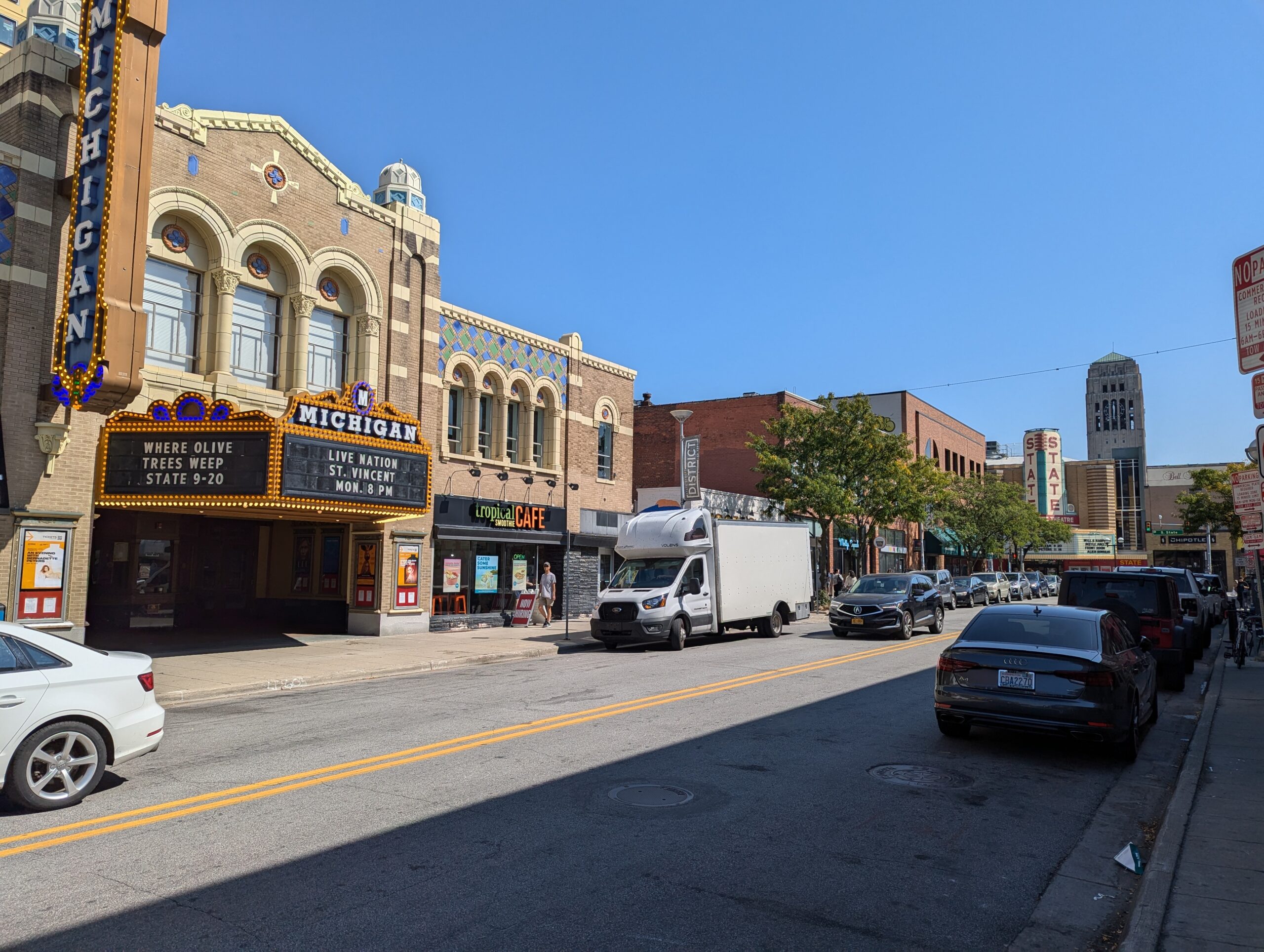Every two years, the Chamber for a Greater Chapel Hill-Carrboro hosts an Inter-City Visit (ICV) – inviting government officials, business leaders, and other local notables to spend two days in another college town, meeting with their officials, leaders, and notables to learn how they address their issues and draw lessons to help us deal with our own issues back home.
This year’s ICV is in Ann Arbor, Michigan – and 97.9 The Hill’s Aaron Keck is with the group. Here is his chronicle of the experience.
So there are two of us, walking together on Liberty Street – walking with purpose, because a CVS pit stop has put us behind and we’re trying to catch up to the group again – when one of us spots it out of the corner of our eye.
The Throne.
“Oh hey, it’s that thing!”
“Ooh, nice.”
The Throne is a modular public restroom – think of it as an upscale, bougie port-a-potty – and Ann Arbor is very excited about it. The city needed public bathrooms (partly for homeless residents, partly for U of M students, partly for everyone else) and a startup company came along to meet the demand. Exciting!
(You know you are a local government nerd when you travel across four states to check out another town’s port-a-johns.)

Carrboro economic development director Jon Hartman-Brown prepares to brave Ann Arbor’s famed Thrones. (Photo by Aaron Keck.)
I’m here in Ann Arbor with about 60 people, folks in local business, town and county government, nonprofits, the university – you name it. (Even Lee Roberts is along for the ride; he really is going all in on community engagement.) This is my fourth ICV, so I know the drill by now: lots of friendly networking amidst a two-day whirlwind tour of the city, with 10 sessions featuring Ann Arbor officials talking about their struggles and solutions on issues like affordable housing, downtown vitality, economic development, climate action – you know, all the same stuff we contend with in Chapel Hill.
The goal is twofold: number one, to build stronger relations with fellow community leaders; number two, to bring back ideas that could turn into actions and better solutions for our own problems at home.
Goal number one, we always achieve. Goal number two? Depends on the year. We’re building wet labs in downtown Chapel Hill in part because we saw a really cool one in Lawrence, Kansas in 2018. And the somewhat-successful push to make West Franklin Street an arts-and-entertainment center was partly inspired by a similar district in Athens, Georgia.
Other times, though, our problems are a little more intractable. A 2016 trip to Boulder, Colorado (average home price $800,000) spooked our local leaders into tripling down on the housing issue, but our housing costs are still through the roof. And every trip invariably ends with everyone excited to go back home and streamline the development process – only for the next ICV group to have that same conversation all over again two years later. (We’ve already had the “let’s streamline the process” conversation, inspired by a particularly impressive Ann Arbor city official who said it’s not the city’s job to be “the guardians of the process,” but rather to be “the facilitators of results.” That line got applause.)
It’s that seeming intractability that’s got me feeling a little pessimistic. Every trip, we spend two days meeting with smart and thoughtful people who are deeply committed to making their community the best it can possibly be – and every trip we find those communities facing exactly the same problems we face, and having the same conversations and debates, often in remarkably similar ways.
Ann Arbor’s a great example. Officials here tell us of a knockdown fight between pro-growth and anti-growth factions that arose in the mid-2010s: the anti-growth folks initially won a surprising City Council majority – but fell out of favor and got swept from office in the last five years when the need for housing became undeniably urgent, not only because housing costs were spiraling but also because tens of thousands of daily out-of-town commuters were making rush-hour traffic a nightmare. We Chapel Hillians look at each other: this all sounds very, very familiar. (Said one later: “Did we even leave Chapel Hill?”)
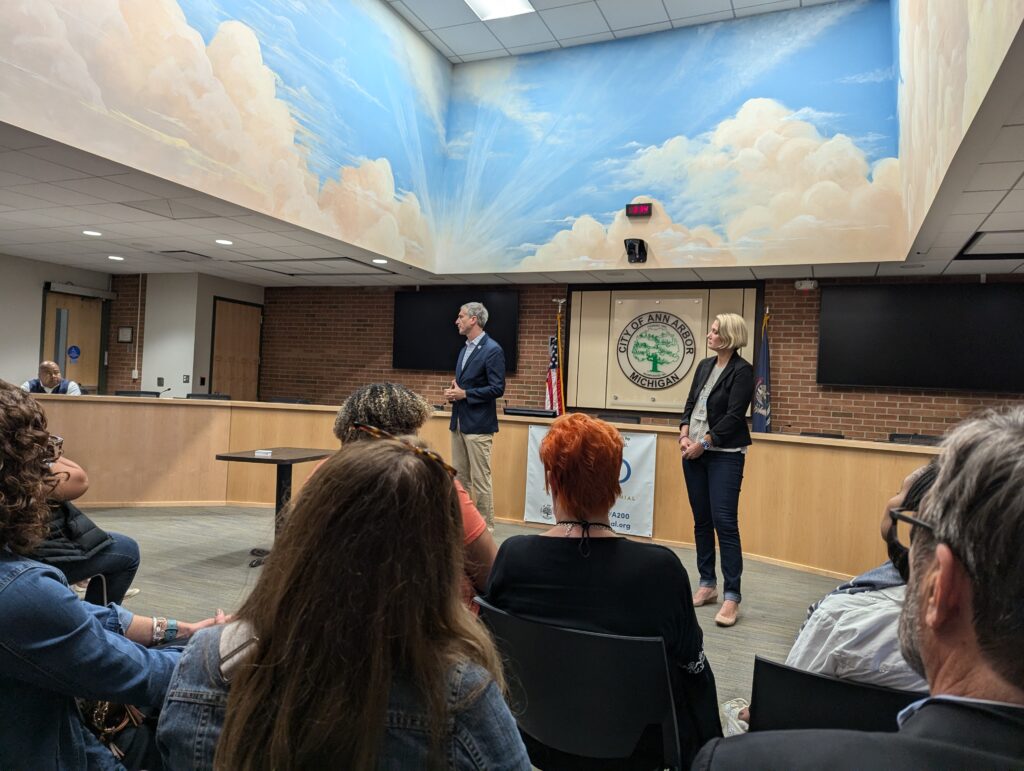
Chapel Hill Mayor Jess Anderson looks on as Ann Arbor’s mayor addresses a question about development. (Photo by Aaron Keck.)
But that begs a troubling question. Are all our local issues just symptoms of bigger macro trends? If so, can we really hope to move the dial, just with our local actions?
We were walking With Purpose down Liberty Street earlier, but I find myself reminded of an opposite concept. Economists sometimes describe the stock market’s movements as a “random walk” – unpredictable, precisely because a stock’s price at any given moment is exactly what all the best economic minds in the world have deemed it to be, so any movement in either direction is something we really couldn’t have seen coming.
Is it the same for local government? In Chapel Hill/Carrboro, we’re blessed with an abundance of smart, experienced, dedicated people who are deeply committed to their community and willing to do the hard work to improve it. Ann Arbor’s the same way.
To the extent that that’s the case: our community (and Ann Arbor) is the way it is because the best people have put in their best efforts to make it the best they possibly could.
Is Chapel Hill on a random walk? Despite all our imperfections, are we as good today as we can reasonably expect to be?
I mean, that would explain why it always seems so difficult to move the dial on those long-standing, never-ending issues, the housing costs and the achievement gaps and the downtown vacancies. And it would explain why every two years, we find ourselves touring another city just like ours, just as full of equally smart and dedicated people, that’s just as burdened with the same imperfections, manifesting themselves in just the same ways.
Or…
Is it still possible to move the dial? Even though our problems still persist despite the sincere efforts of great people, is there still an avenue for progress we haven’t discovered, a new idea we haven’t tried?
For sure.
After all, we’ve achieved a lot already in Chapel Hill and Carrboro: housing costs are starting to tick down, downtown parking’s getting easier (conventional wisdom notwithstanding), we’re measurably closer to carbon neutrality, we’ve got a fantastic infrastructure for local startups that didn’t exist 20 years ago – and here in Ann Arbor, we’re seeing how this city is making real progress too. (Perhaps most notably, they’re ahead of us in climate action, with an incredibly ambitious plan that’s still on track to achieve community-wide carbon neutrality by 2030.) The ‘random walk’ is an interesting idea, but economists also know the reality is more complex – and the same is true when it comes to improving local communities.
So how do we do it?
Ann Arbor’s experience suggests two important ways.
The first just involves focused leadership. Ann Arbor recently went through a period of contentious transition and turnover (plus a 15 percent staff cut) but emerged with a leadership team that’s got a ton of experience getting things done. They do it by harnessing relationships: working on town/gown relations, for instance, and persuading the University of Michigan to contribute funds for community improvement projects (like those aforementioned Thrones). They do it by focusing on storytelling, improving and personalizing the way they explain the importance of their work. (This also involves some spending: the city now employs a federal lobbyist, to push for Ann Arbor’s interests in Congress.) And they do it by snowballing on their past successes, building public confidence by making progress on long-simmering problems – downtown road repair, for instance, or taking down blighted buildings. (Seems Ann Arbor had its own version of Hillsborough’s Colonial Inn.) Said one city official: “in the psyche of your community, you have to demonstrate that the hard things people want to get done actually can happen.” That sometimes takes a long time – but it can pay off in the end.
And the second way to move the dial involves harnessing new, innovative ideas that weren’t on the table before. Back to the Throne, where we began: it took just one small team of entrepreneurs to develop an idea to address an old problem; it took a startup-friendly infrastructure to give that team the resources, support, and space they needed to get their idea off the ground; it took a vibrant network to connect that team with the city officials who could make it happen; and it took city officials that were open and excited about hearing new ideas and trying new things. Get all four of those things together, and you can make progress you haven’t made before.
Said our Ann Arbor official: “We’re not competing with other communities – we’re competing with our own potential.” That’ll be one of the big lessons of this year’s ICV – whether or not we specifically bring Thrones to Franklin Street.
But don’t be too surprised if we do.
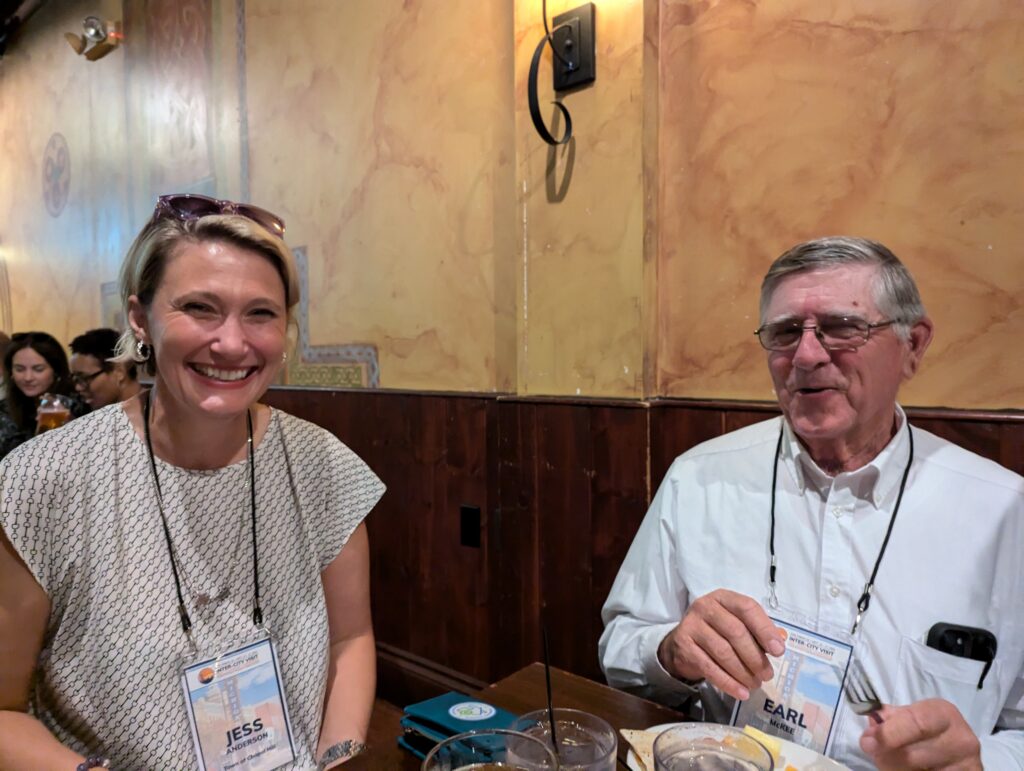
Orange County Commissioner Earl McKee and Chapel Hill Mayor Jess Anderson. As to what they’re talking about, I’m sworn to secrecy. (Photo by Aaron Keck.)
Featured photo: Chamber president Aaron Nelson addressing the ICV attendees at a restaurant in Ypsilanti, next door to Ann Arbor.
Chapelboro.com does not charge subscription fees, and you can directly support our efforts in local journalism here. Want more of what you see on Chapelboro? Let us bring free local news and community information to you by signing up for our newsletter.

